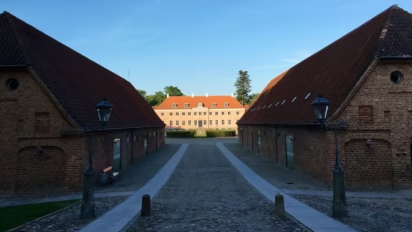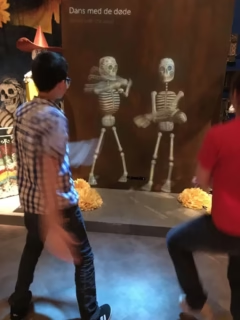The Moesgaard Museum near Aarhus in Denmark is one of Scandinavia’s best with prehistory (Bronze / Iron / Vikings Ages) and anthropology exhibitions.
The Moesgaard Museum (MoMu) is a superb archaeological and ethnographic museum near the city Aarhus on the Danish Jutland peninsula. The prehistory exhibitions concentrate on especially Danish archaeology with superb displays on the Bronze Age, the Iron Age, and the Viking Era. Major items here include the Grauballe Man and Iron Age weapon caches found in the Illerup Ådal lake. The anthropology exhibition focuses on “the life of the dead” not only in Denmark but also around the world. Superb temporary exhibitions – usually of historically important but not directly related themes – continue to draw in visitors. As do the modern architecture of the new museum building (2014) that allows visitors to walk freely on its grass-covered sloping roof.
The Exhibitions of the Moesgaard Museum
The Moesgaard Museum was established in 1970 near Aarhus on the Jutland peninsula of Denmark. It is particularly known for its vast collection of Danish archaeological finds and rates only behind the National Museum of Denmark in Copenhagen in scale and quality. However, some of the Moesgaard Museum’s top displays – such as the Grauballe Man and Bronze Age Borum Eshøj bodies – have no equals in the world.
The Moesgaard Museum re-opened in 2014 in a new modern facility with masterful and imaginative presentations using the latest technology and methods. Without dumbing it down, visitors of all interest levels will find it easy and enjoyable to visit the exhibitions.
The exhibitions of the Moesgaard Museum are easy to navigate and may be grouped into three main areas:

- Temporary exhibitions (on the ground floor) of spectacular nature and size are designed to attracted visitors from afar and to draw locals back to the museum at least annually. Previous themes included the Chinese terracotta army and Roman gladiators.
- The anthropology exhibition (upper floor) focusing on the life of the dead and how death is treated in various cultures around the world.
- The Prehistory exhibitions (lower floor) are the largest and most important part of the museum. The exhibitions here are grouped into the Bronze Age, Iron Age, and Viking era with special emphasis on the beginnings of human life in Denmark.
A few further smaller temporary exhibitions are often staged in parts of the museum while the evolution stairway with models of seven famous prehistoric human species is also interesting.
Prehistory Exhibitions in the Moesgaard Museum
The prehistory exhibitions of mostly Danish archaeological finds are the most important and most interesting part of the Moesgaard Museum. If time is limited, spend all of it here.
The prehistory exhibitions are divided into three main themes: the Bronze Age, Iron Age, and Viking Age with the first two particularly interesting (and easy enough to pass off as part of the Vikings when visiting with smaller children).
The Bronze Age (1700 – 500 BC)
This part of the exhibition focuses on the origins of humans in Denmark with some of the oldest archaeological finds in Denmark. The Bronze Age humans in the region probably worshipped the sun and had deep knowledge of astronomy.
The most important exhibit here is the well-preserved remains of a family that was buried more than 3350 years ago in oak coffins in the Borum Eshøj barrow west of Aarhus. These three bodies are amongst the best-preserved prehistoric people in the world with hair, nails, and even clothes still on their bodies,
The Iron Age (500 BD – AD 800)
Discoveries from the Iron Age are naturally more numerous and this large section of the museum is the most interesting.
Surprisingly, the most important exhibit here has nothing to do with the technological advancement of humankind: the Grauballe Man is the world’s best-preserved prehistoric bog body.
This man died over 2000 years ago: his throat slit – probably as religious sacrifice – and the bog preserved his body so well that his fingerprints could be taken when the body was rediscovered in 1952.
Even more prominently displayed are some of the around 15,000 weapon fragments found in the Illerup Ådal.
Following a very large Iron Age battle in AD 205 the victorious army offered to the gods this huge collection of arms – broken on purpose and sunk into the lake in bundles.
The Viking Age (800 – 1066)
Following the tour de force of the previous two exhibitions, the Viking Era struggles a bit to maintain the same high standard. The best items from this period are exhibited in other museums.
Rather than presenting a chronological display of Viking history, a variety of items and interactive displays take visitors to various exotic regions that the Vikings traded (and fought) with. This section is the easiest for children to enjoy too and has many interactive displays and hands-on activities.
(In downtown Aarhus near the cathedral is a small, free Viking Museum showing the Viking origins of Aros.)
The Anthropology Exhibition of the Moesgaard Museum
The anthropology exhibition is quite different from the Danish prehistory section but still well worth at least a stroll through. The theme here is the life of the dead – how different societies experience death and keep memories alive.
The main exhibitions here are not Danish but rather from Australia, Africa, Asia, and a very large section on the Mexican Day of the Dead, which is a colorful celebration often accompanied by parties in graveyards.
Moesgaard Museum Roof and Hiking Trail
The ultra-modern building of the Moesgaard Museum opened in 2014. It is designed to blend in while simultaneously standing out from the natural surroundings. It is famous for its grass-covered sloping roof that visitors are welcome to walk on and enjoy the views of the surrounding countryside and the sea.
The country manor house that was home to the museum from the 1970s to a few years ago is now mostly closed to visitors. It is used by the archeology and anthropology departments of Aarhus University.
A few reconstructions and outdoor displays are scattered around near the old building but these are fairly low-key and should be a lower priority.
A trail leads from the museum through the ancient forest to the beach and back. It passes by some original Viking and prehistoric sights such as tumuli. It is a pleasant walk but it is easy to lose the trail and the Viking sights are really low-key, although it is actually quite amazing how dry sand moats and defense walls could have survived in some recognizable form without any special conservation effort for all these centuries.
Visiting the Moesgaard Museum with Children
The Moesgaard Museum is a great destination for families with children of all ages. The main displays are easy to enjoy with many interactive displays and activities to keep children occupied.
For example, in the Viking Era section visitors may try to steer a Viking boat using modern electronic sensors and displays. In the Day of the Dead section, dance to Mexican music while body movements are replicated by dancing skeletons on the screen. Use building blocks to write your name in runic – in several competing versions.
Moesgaard Museum Visitors Information
The Moesgaard Museum is a good half-day trip from Aarhus and it would be easy to spend a full day here. Even a fairly cursory glance at all the displays takes at least two hours. Fortunate are those living close by who could focus on only one section and come back to enjoy the rest on another day.
The very pleasant café serves typical modern Scandinavian cuisine. On a busy day, it is a good idea to lunch early or late.
Virtually all descriptions in the museum are in both Danish and English. The language used is often not stifled or boring:
- “The Viking Age is the story of Scandinavian seafarers with the wind at their backs.”
Admission Tickets to the Moesgaard Museum
Tickets for the Moesgaard Museum are DKK110 with free admission for children under 18.
Tickets may be bought online but the system is currently available only in Danish.
Admission to the roof, café, and the outdoor displays are free.
Opening Hours of the Moesgaard Museum
The Moesgaard Museum is open Tuesday to Sunday from 10:00 to 17:00, closing at 21:00 on Wednesday.
The museum is open on most holidays, but not December 24, 25, and 31 or January 1.
During some school holidays, the museum is open on Monday too with later closing times on some summer days.
The largest Viking re-enactment battle and festival is held near Moesgaard during late July.
Transportation to the Moesgaard Museum
Moesgaard Museum, Moesgård Allé 15, 8270 Højberg, Denmark, is around a kilometer south of the city limits of Aarhus. It is easily reached by bus, bicycle or car with plenty of free parking.
The Moesgaard Museum is in Moesgård Allé – like Aarhus changing the city name from Århus, the Moesgaard Museum prefers the more modern and internet-friendly spelling with a double aa, which in the Danish alphabet is still a single letter and the final one of 29.
City bus 18 leaves Park Allé for the Moesgaard Museum up to four times per hour on weekdays and at least twice per hour on weekends. The journey takes just less than half an hour with the museum the final stop. Bus tickets are DKK20 for adults and DKK10 for children; up to two children may travel for free with an adult. Payment on the bus is in cash only.
Other Aarhus and Prehistory Museums
The Moesgaard Museum is one of the three great museums in the Aarhus region of Denmark. The other two are near the city center: the Den Gamle By (old town) outdoor museum and the ARoS art museum.
Other Danish museums with important prehistory and Viking collections include the National Museum of Denmark in Copenhagen that has generally the top finds and the Vikings Ships Museum in Roskilde. Smaller sites include the Viking Museum Ladby (burial ship), Trelleborg (Viking fortress), Fyrkat (Viking fort and farm), and a small free Viking museum near Aarhus cathedral.
See more Moesgaard Museum photos on Flickr.
















